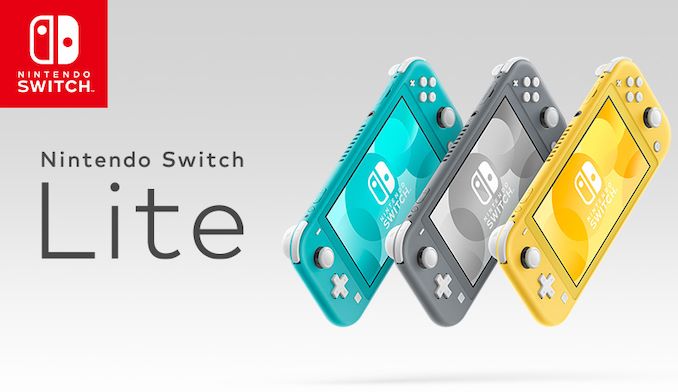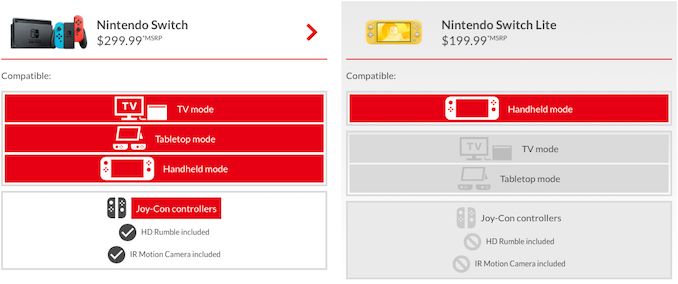Update: Nintendo Reveals Handheld-Only Switch Lite, With a New NVIDIA SoC
by Anton Shilov on July 10, 2019 4:00 PM EST
Nintendo has announced a new version of its Switch game console that only works in handheld mode, yet it is considerably more compact, comes at a lower price point, and works for a longer time on one charge. One of the intrigues about the Switch Lite device is that it might be is powered by a new NVIDIA Tegra SoC, presumably made using a more advanced process technology.
The Nintendo Switch Lite comes with a 5.5-inch LCD featuring a 720p resolution and has built-in controllers that have the same layout as Nintendo’s Joy-Con controllers. The console will support local and online multiplayer modes and will allow up to eight people to play at once anywhere with Wi-Fi. When it comes to style, the gaming device will come in grey, yellow, and turquoise to attract gamers with different tastes. As far as availability is concerned, the Switch Lite will ship on September 20 and will cost $199.99 (down from $299.99 in case of the fully-fledged version).
Since the console is designed for games that support Handheld mode, it cannot connect to TV, work in tabletop mode (because it does not have a kickstand), is not compatible with the Switch dock, does not support HD Rumble as well as IR Motion Camera. The said limitations are fully justified for mobile gaming as the new Switch Lite console is considerably more compact, it weighs 122 grams (0.27 pounds) less, and it works for three to seven hours (up from 2.5 – 6.5 hours in case of the original Switch). The more notable battery life comparison is the 3 hour vs 4 hour gameplay estimate given for Zelda's Breath of the Wild, which is a 33% increase over the original Switch, pointing out to larger efficiency boosts of the hardware.
The longer battery life of the Switch Lite, despite its smaller dimensions (and a lower-capacity battery) may indicate that the SoC inside the Switch Lite – which NVIDIA has confirmed they're powering – is based on an updated Tegra design produced on a more advanced fabrication process. The original Tegra X1 chip was manufactured on TSMC's 20nm process node, which was not exactly the best node when it comes to power efficiency. Recently we've seen evidence of a revision of the X1 with notable changes in the operating voltages of the chip, which point out that this very well might be a die shrink. We believe that it's likely that the new chip is manufactured in a 16nm or 12nm process node.
| Nintendo's Handheld Game Console Specification Comparison | |||||
| Nintendo Switch | Nintendo Switch Lite | ||||
| SoC | NVIDIA Tegra X1 4x ARM Cortex-A57 NVIDIA Maxwell (256 CUDA Cores) |
NVIDIA SoC (12/16nm Tegra X1 Shrink?) |
|||
| Display | 6.2-inch 1280x720p LCD (HDMI: 1080p60) |
5.5-inch 1280x720p LCD | |||
| Size | 102 x 239 x 13.9 mm, 297g (tablet only) 398g w/Joy-Cons |
91.4 x 208 x 13.9 mm, 277 g | |||
| Battery | 4310 mAh (~ 16Whr) 2.5 to 6.5 Hours 3 hours BotW gameplay |
3570 mAh (~13.2Whr) 3 - 7 Hours 4 hours BotW gameplay |
|||
| Storage | 32 GB NAND + microSDXC | 32 GB NAND + microSDXC | |||
| Wireless | 802.11ac Bluetooth 4.1 |
802.11ac Bluetooth 4.1 |
|||
| I/O | Console | USB Type-C | USB-C (power only)- | ||
| Dock | 1x USB 3.0 2x USB 2.0 1x HDMI 1.x 1x USB-C (power only) |
||||
| Launch Date | 03/03/2017 | 09/20/2019 | |||
| Launch Price | $299 | $199 | |||
Neither Nintendo nor NVIDIA have confirmed usage of a new Tegra X1 inside the Switch Lite console.
One interesting note is that while Nintendo hasn't detailed the specifications of the new handheld, they have allowed partner NVIDIA to confirm that they're powering it, leading a good deal of further credit to the theory that the console is being powered by a die shrunk descendant of the Tegra X1.
#WePowerIthttps://t.co/l3AKDR1pD4
— NVIDIA GeForce (@NVIDIAGeForce) July 11, 2019
NVIDIA, of course, was a close partner in developing the original Switch. Along with providing the Tegra X1 SoC inside of it, NVIDIA has supplied a good chunk of the graphics software stack, with Nintendo opting to leverage their experience there. Using another NVIDIA SoC was a foregone conclusion for the Switch Lite, given the compatibility needs, but with secretive Nintendo it's rare to get official confirmation so early on.
Meanwhile, as soon as the Japanese gaming giant launches the new product in September, we will find out for sure what is inside after the console gets teared down.
Related Reading:
- Playing With Power: A Look At Nintendo Switch Power Consumption
- Nintendo Switch Hardware Launch Details - 32GB w/Expandable Storage, 6.2” 720p Screen, 2.5 to 6.5 Hour Battery Life
- Nintendo Announces Switch Portable Gaming Console - Powered by NVIDIA Tegra
Sources: Nintendo, Nintendo.de












51 Comments
View All Comments
willis936 - Wednesday, July 10, 2019 - link
I don’t think the deal with nvidia and the nintendo switch is that kind of deal. Nintendo pays bargain bin prices for bargain bin chips. It’s an old design on an old process. It is unlikely that nintendo would pay for any serious semi custom silicon.willis936 - Wednesday, July 10, 2019 - link
That being said my first instinct here is that the better battery life is achieved with lower clocks on a smaller process. Smaller process alone wouldn’t double battery life.GreenReaper - Wednesday, July 10, 2019 - link
Where are you getting double? It's 33% more, if that. A smaller screen is likely a big part of that.willis936 - Wednesday, July 10, 2019 - link
With less space for the battery. It would be more accurate if I said double the efficiency to do the same task, but I figured what I meant made enough sense from context.PeachNCream - Wednesday, July 10, 2019 - link
It made sense to me.blu42 - Thursday, July 11, 2019 - link
Efficiency didn't double -- it went from 4310mAh to 3570mAh and from 3.5h to 4, ergo efficiency increased by ~38%. Which is perfectly within the limits of a fabnode shrink + reduced display consumption. And of course no (hand-held) clocks were dropped, otherwise switch games would underperform on the lite.willis936 - Thursday, July 11, 2019 - link
Where did you get 3750 mAh?Also it went from 3 hours on botw to 4 hours. 33% increase. You’re the first to disagree with that.
Assuming that 3570 mAh number is correct they are lasting +33% longer on -17% battery capacity. Interestingly that is exactly a doubling of efficiency.
38% is not anywhere close to an expected amount of power reduction from a process shrink. Just look at generational numbers.
Also display power scales (roughly) linearly with display area. The display on the switch lite is 21% smaller than the switch. A process shrink and nothing else (what this likely is, as these are cheap chips) will maybe net 15% efficiency max. Where is the other 15% if not in lower clocks?
willis936 - Thursday, July 11, 2019 - link
To run the numbers:3.7 V * 4.31 Ah = 16.0 Wh
3.7 V * 3.57 Ah = 13.2 Wh
16.0 Wh / 3 h = 5.3 W
13.2 Wh / 4 h = 3.3 W
1 - (3.3 W / 5.3 W): 38% increase in efficinecy
ajp_anton - Friday, July 12, 2019 - link
Math fail on the 1- at the end, but otherwise correct. Regardless of if higher or lower is better, you can always take bigger/smaller and say "this much higher", or smaller/bigger and say "this much lower".5.3/3.3 = 1.61, so 61% higher. 5.3W is 61% higher power than 3.3W, and 3.3W is 61% higher efficiency than 5.3W.
3.3/5.3 = 0.62, so 38% lower. 3.3W is 38% lower power than 5.3W, and 5.3W is 38% lower efficiency than 3.3W.
blu42 - Thursday, July 11, 2019 - link
I thought I saw 3570mAh in the article, but I don't see it now, so article either got updated, or I saw it in the comments (there's one on the next page referring to the same mAh numbers, so I didn't imagine those).I stand corrected on the 3h -> 4h increase -- I misquoted those. So that's 33% increase in battery span. On a presumed 83% battery capacity, that's nowhere near doubling in power efficiency, it's 133 / 0.83 = 161, or 61% of efficiency improvement.
Re power efficiency improvements from process shrink, 20nm -> 16FF+ is 60%
https://www.anandtech.com/show/13445/tsmc-first-7n...
Of course that's just the SoC -- the rest of the components (mostly the display) will have different power improvements.